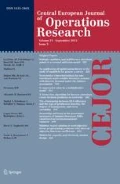Abstract
Interval linear programming provides a tool for solving real-world optimization problems under interval-valued uncertainty. Instead of approximating or estimating crisp input data, the coefficients of an interval program may perturb independently within the given lower and upper bounds. However, contrarily to classical linear programming, an interval program cannot always be converted into a desired form without affecting its properties, due to the so-called dependency problem. In this paper, we discuss the common transformations used in linear programming, such as imposing non-negativity on free variables or splitting equations into inequalities, and their effects on interval programs. Specifically, we examine changes in the set of all optimal solutions, optimal values and the optimal value range. Since some of the considered properties do not holds in the general case, we also study a special class of interval programs, in which uncertainty only affects the objective function and the right-hand-side vector. For this class, we obtain stronger results.


Similar content being viewed by others
References
Allahdadi M, Nehi HM (2012) The optimal solution set of the interval linear programming problems. Optim Lett 7(8):1893–1911. https://doi.org/10.1007/s11590-012-0530-4
Cerulli R, D’Ambrosio C, Gentili M (2017) Best and worst values of the optimal cost of the interval transportation problem. In: Sforza A, Sterle C (eds) Optimization and decision science: methodologies and applications: ODS, Sorrento, Italy, September 4–7, 2017, Springer International Publishing, Cham, pp 367–374. https://doi.org/10.1007/978-3-319-67308-0_37
Chanas S, Dubois D, Zielinski P (2002) On the sure criticality of tasks in activity networks with imprecise durations. IEEE Trans Syst Man Cybern B Cybern 32(4):393–407. https://doi.org/10.1109/TSMCB.2002.1018760
Cheng G, Huang G, Dong C (2015) Convex contractive interval linear programming for resources and environmental systems management. Stoch Environ Res Risk Assess 1–20. https://doi.org/10.1007/s00477-015-1187-1
Fortin J, Zieliński P, Dubois D, Fargier H (2010) Criticality analysis of activity networks under interval uncertainty. J Scheduling 13(6):609–627. https://doi.org/10.1007/s10951-010-0163-3
Grošelj P, Stirn LZ (2017) Consensus model for group decision problems with interval weights. In: Zadnik Stirn L et al (ed) Proceedings of the 14th international symposium on operational research SOR’17, Bled, Slovenia, September 27–29, 2017, Slovenian Society Informatika, Ljubljana, Slovenia, pp 535–540
Hladík M (2008) Tolerances in portfolio selection via interval linear programming. In: Rehorova P, Marsikova K, Hubinka Z (eds) Proceedings 26th int. conf. mathematical methods in economics MME08, Liberec, Czech Republic, Technical University Liberec, pp 185–191
Hladík M (2009) Optimal value range in interval linear programming. Fuzzy Optim Decis Mak 8(3):283–294. https://doi.org/10.1007/s10700-009-9060-7
Hladík M (2012) Interval linear programming: a survey. In: Mann ZA (ed) Linear programming—new frontiers in theory and applications. Nova Science Publishers, New York, pp 85–120 chap 2
Hladík M (2017) Transformations of interval linear systems of equations and inequalities. Linear Multilinear Algebra 65(2):211–223. https://doi.org/10.1080/03081087.2016.1180339
Kumar P, Panda G, Gupta U (2016) An interval linear programming approach for portfolio selection model. Int J Oper Res 27(1–2):149–164. https://doi.org/10.1504/IJOR.2016.078463
Lai KK, Wang SY, Xu JP, Zhu SS, Fang Y (2002) A class of linear interval programming problems and its application to portfolio selection. IEEE Trans Fuzzy Syst 10(6):698–704. https://doi.org/10.1109/TFUZZ.2002.805902
Li W (2015) A note on dependency between interval linear systems. Optim Lett 9(4):795–797. https://doi.org/10.1007/s11590-014-0791-1
Mráz F (1998) Calculating the exact bounds of optimal values in LP with interval coefficients. Ann Oper Res 81:51–62. https://doi.org/10.1023/A:1018985914065
Novotná J, Hladík M, Masařík T (2017) Duality gap in interval linear programming. In: Zadnik Stirn L et al (ed) Proceedings of the 14th international symposium on operational research SOR’17, Bled, Slovenia, September 27–29, 2017, Slovenian Society Informatika, Ljubljana, Slovenia, pp 501–506
Oettli W, Prager W (1964) Compatibility of approximate solution of linear equations with given error bounds for coefficients and right-hand sides. Numer Math 6(1):405–409. https://doi.org/10.1007/bf01386090
Oliveira C, Antunes CH (2009) A multiobjective model for integrated sustainable planning under uncertainty. In: Grasserbauer M, Sakalauskas L, Zavadskas EK (eds) Proceedings of the EURO mini-conference—5th international Vilnius conference knowledge-based technologies and OR methodologies for strategic decisions of sustainable development (KORSD-2009), pp 137–142
Rohn J (2006a) Interval linear programming. In: Linear optimization problems with inexact data. Springer US, pp 79–100. https://doi.org/10.1007/0-387-32698-7_3
Rohn J (2006b) Solvability of systems of interval linear equations and inequalities. In: Linear optimization problems with inexact data, Springer US, pp 35–77. https://doi.org/10.1007/0-387-32698-7_2
Safi M, Razmjoo A (2013) Solving fixed charge transportation problem with interval parameters. Appl Math Model 37(18–19):8341–8347. https://doi.org/10.1016/j.apm.2013.03.053
Wendell RE, Chen W (2010) Tolerance sensitivity analysis: thirty years later. Croatian Oper Res Rev 1(1):12–21
Author information
Authors and Affiliations
Corresponding author
Additional information
The first two authors were supported by the Czech Science Foundation under Grant P403-18-04735S and by the Charles University, Project GA UK No. 156317. The third author was supported by the Czech Science Foundation under Grant P403-17-13086S.
Rights and permissions
About this article
Cite this article
Garajová, E., Hladík, M. & Rada, M. Interval linear programming under transformations: optimal solutions and optimal value range. Cent Eur J Oper Res 27, 601–614 (2019). https://doi.org/10.1007/s10100-018-0580-5
Published:
Issue Date:
DOI: https://doi.org/10.1007/s10100-018-0580-5




